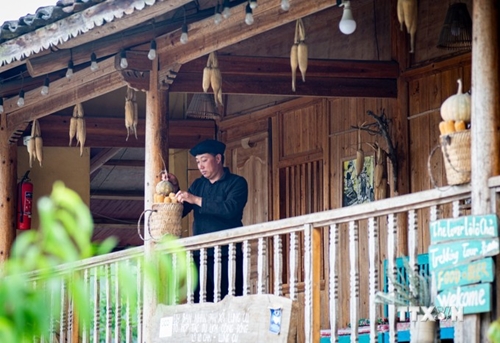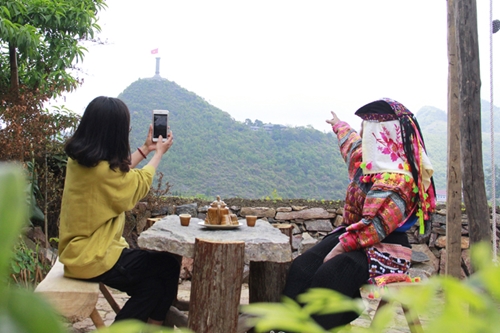Sitting inside the homestay of his family, Sinh Di Gai, the head of Lo Lo Chai village, recounts the early days of starting tourism. It was in 2011 when the Embassy of Luxembourg collaborated with the People's Committee of Dong Van District and the People's Committee of Lung Cu Commune to guide the Lo Lo Chai community in community-based tourism.
    |
 |
|
Sinh Di Gai and his homestay (Photo: VNA) |
With the determination to overcome poverty and enrich their village, Gai and two households took the lead in engaging in tourism. Starting with humble beginnings, Gai renovated a kitchen and the main house. By 2013, as the number of tourists increased, his family focused on developing additional services. In 2014, Gai built a traditional house for the Lo Lo people, and by 2017, he invested in another homestay accommodation. As of now, his family operates three homestay areas to serve visitors.
Currently, the village has 28 households participating in community-based tourism and establishing a tourism cooperative. They are harnessing the local potential, investing in construction, and operating tourism services with a total of 150 guest rooms. Lo Lo Chai has become a prominent model in Dong Van District, listed on Ha Giang’s tourism map and included in geographical directions for visitors to find their way. On average, Lo Lo Chai welcomes over 12,000 visitors annually, especially during the year-end and buckwheat blossom season. The continuous influx of tourists coming to explore and experience has improved the living standards of many families in the village. More families are investing in their homestays to enhance the quality of accommodations.
After more than 10 years in the tourism industry, a new vitality has arrived in Lo Lo Chai village. The community is no longer trapped in poverty. Instead, the locals can now speak English and generate decent income from tourism. The village has also become a gathering point for cultural exchanges and promotion of the Lo Lo ethnic group's heritage.
    |
 |
|
The village has also become a gathering point for cultural exchanges and promotion of the Lo Lo ethnic group's heritage. (Photo: baotnvn.vn) |
Ma Doan Khanh, Chairman of the People's Committee of Lung Cu commune, stated that the community-based tourism products in Lo Lo Chai have been certified with a 3-star OCOP (One Commune, One Product) rating, opening up opportunities for sustainable tourism development. Currently, the commune is actively implementing comprehensive solutions to enhance criteria, preserve and conserve the traditional cultural values of the ethnic community, and transform tourism into a key economic sector.
According to Nguyen Van Chinh, Vice Chairman of the People's Committee of Dong Van District, Lo Lo Chai has successfully preserved many aspects of its traditional culture, with houses that have been passed down through generations of the Lo Lo people. Thanks to good planning and a well-executed approach to tourism, the traditional houses have been renovated by households, adding enclosed sanitation facilities to accommodate visitors for dining, resting, and daily activities, without compromising the exterior architecture and overall landscape.
“Tourism not only helps improve the village’s appearance but also provides local residents with the opportunity to preserve traditional crafts and maintain the cultural identity of the ethnic community. The Lo Lo Chai brocade weaving cooperative was established with the assistance of the Women's Union chapter of Dong Van District. The handicraft products not only promote the cultural heritage of the Lo Lo people through traditional costumes but also generate incomes for local residents,” Chinh stated.
    |
 |
|
Capturing the beauty of the nation from Cuc Bac (Northern Pole) Café (Photo: baotnvn.vn) |
Lo Lo Chai has also established a Folk Art Association. Twenty-six traditional dances performed with bronze drums, such as lullabies, wedding songs, funeral songs, and love songs, are showcased to visitors, enriching tourism activities with diversity and vibrancy. This humble village in the far north of the country has become a tourist destination that not only preserves the cultural, historical, and natural values of the locality but also brings economic benefits to the community, instilling a sense of ethnic pride and inspiring widespread societal engagement.
Translated by Chung Anh